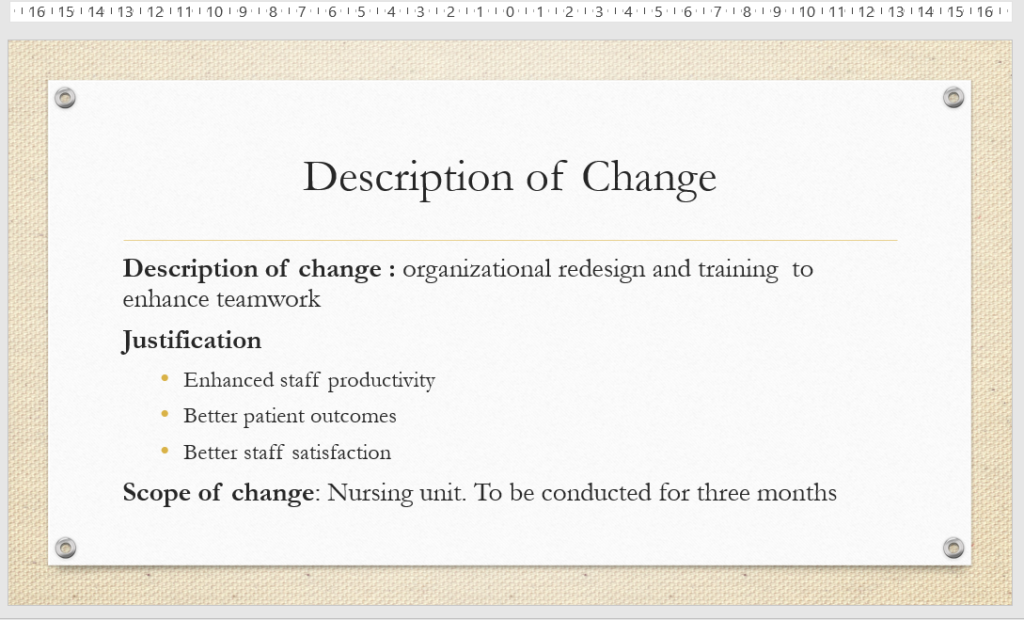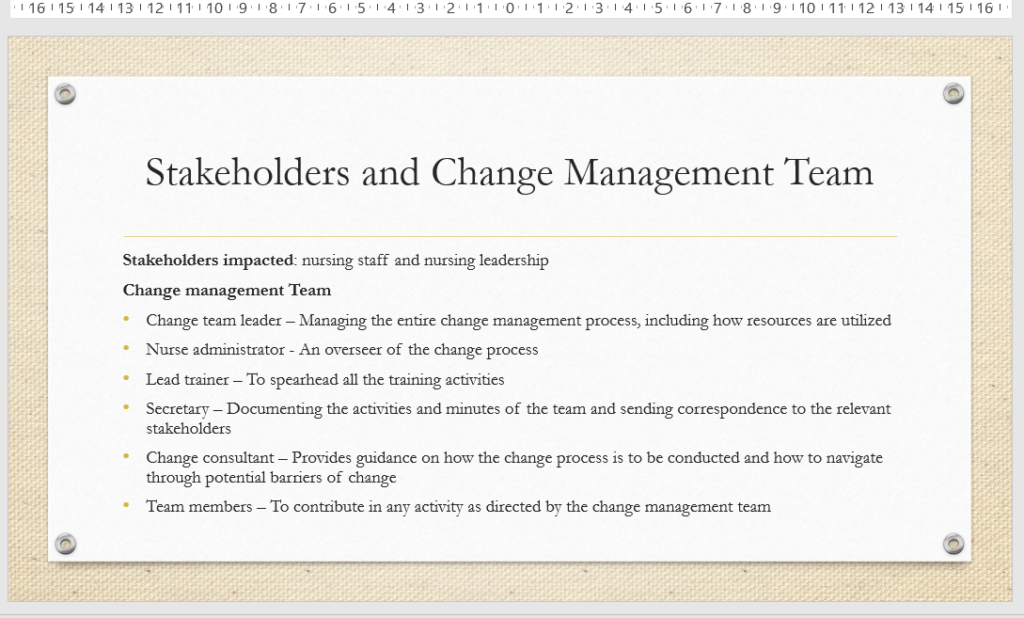Assignment: Change Implementation and Management Plan It is one of the most cliché of clichés, but it nevertheless rings true: The only constant is change. As a nursing professional, you are no doubt aware that success in the healthcare field requires the ability to adapt to change, as the pace of change in healthcare may be without rival. As a professional, you will be called upon to share expertise, inform, educate, and advocate. Your efforts in these areas can help lead others through change. In this Assignment, you will propose a change within your organization and present a comprehensive plan to implement the change you propose. To Prepare: Review the Resources and identify one change that you believe is called for in your organization/workplace. This may be a change necessary to effectively address one or more of the issues you addressed in the Workplace Environment Assessment you submitted in Module 4. It may also be a change in response to something not addressed in your pr
Expert Answer and Explanation

- One of the issues that was observed within the organization, which also came out in the workplace civility assessment is low levels of teamwork. Currently, the employees prefer to work independently with no indication of any form of teamwork. This to some extent, increases the likelihood of organizational conflicts.
- The lack of teamwork can also be attributed to the leadership in place. The organization currently leans towards a more transactional form of leadership which focuses more on tasks, with very minimal teamwork in place (Marshall & Broome, 2017). Therefore, the intervention selected will help to resolve this issues.

- The change proposed will include a redesigning the organization, specifically the nursing unit to factor in teams as core components of achieving high levels of efficiency and productivity. In the change, nurses will be placed into small effective and diverse teams, with the team leaders answering to the overall nurse leader in a given shift. Training on teamwork and transformational leadership will also be conducted to orient the nurses on what is expected of the as pertains to the new model.
Justification
- Studies have linked teamwork with better productivity and low burnout among the nursing staff. In a study by (Halm, 2019), it was noted that high levels of teamwork helps to reduce the individual workload and work-related stress thus reducing the burnout phenomenon amongst nurses. Teamwork is also linked with high levels of employee satisfaction (Buljac-Samardzic et al., 2020). Patients also benefit from teamwork, given that teamwork is linked with reduced incidents of missed care events and medical errors (Marguet & Ogaz, 2019).
Scope of change
- For start, the proposed change will be limited to the nursing unit and later extended to the entire organization. The change project will be conducted for 3 months.

- The stakeholders who will be affected by the change process include the nursing staff, including the nurse leaders. The nurse leaders will be trained on the transformational style of leadership and the attached advantages (Marshall & Broome, 2017).
Change management team
- The change management team will have the following people;
- Change team leader – the role of the change leader will be to head the entire change management process, she will preferably hold a position of nurse manager or above.
- Nurse administrator -as an overseer of the change process
- Lead trainer – to spearhead all the training activities. Depending on the training, an external trainer may be require
- Secretary – in charge of documenting the activities and minutes of the team and sending correspondence to the relevant stakeholders
- Change consultant – Provides guidance on how the change process is to be conducted and how to navigate through potential barriers of change
- Team members – to contribute in any activity as directed by the change management leader and the trainers

- Communication in the change initiative is vital in ensuring its success. Proper communication is also important in preventing potential resistance of the change process (Pollack & Pollack, 2015). To ensure that communication is successfully achieved, a comprehensive communication plan will need to be established. The plan will have five main steps.
- The first is to identify the stakeholders to be communicated to.
- The second step will involve coming up with a timeline of communication, which should be convenient to all stakeholders.
- After coming up with a communication timeline, it will also be wise to identify the most appropriate medium of communication that will be used for each stakeholder to ensure that the communication is successfully completed.
- The fourth step is to communicate with the stakeho